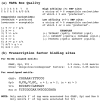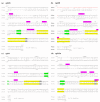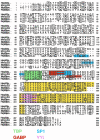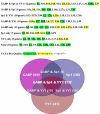The architecture of mammalian ribosomal protein promoters
- PMID: 15707503
- PMCID: PMC554972
- DOI: 10.1186/1471-2148-5-15
The architecture of mammalian ribosomal protein promoters
Abstract
Background: Mammalian ribosomes contain 79 different proteins encoded by widely scattered single copy genes. Coordinate expression of these genes at transcriptional and post-transcriptional levels is required to ensure a roughly equimolar accumulation of ribosomal proteins. To date, detailed studies of only a very few ribosomal protein (rp) promoters have been made. To elucidate the general features of rp promoter architecture, I made a detailed sequence comparison of the promoter regions of the entire set of orthologous human and mouse rp genes.
Results: A striking evolutionarily conserved feature of most rp genes is the separation by an intron of the sequences involved in transcriptional and translational regulation from the sequences with protein encoding function. Another conserved feature is the polypyrimidine initiator, which conforms to the consensus (Y)2C+1TY(T)2(Y)3. At least 60 % of the rp promoters contain a largely conserved TATA box or A/T-rich motif, which should theoretically have TBP-binding capability. A remarkably high proportion of the promoters contain conserved binding sites for transcription factors that were previously implicated in rp gene expression, namely upstream GABP and Sp1 sites and downstream YY1 sites. Over 80 % of human and mouse rp genes contain a transposable element residue within 900 bp of 5' flanking sequence; very little sequence identity between human and mouse orthologues was evident more than 200 bp upstream of the transcriptional start point.
Conclusions: This analysis has provided some valuable insights into the general architecture of mammalian rp promoters and has identified parameters that might coordinately regulate the transcriptional activity of certain subsets of rp genes.
Figures






Similar articles
-
Identification of highly specific localized sequence motifs in human ribosomal protein gene promoters.Gene. 2006 Jan 3;365:48-56. doi: 10.1016/j.gene.2005.09.033. Epub 2005 Dec 15. Gene. 2006. PMID: 16343812
-
Functional dissection of a mouse ribosomal protein promoter: significance of the polypyrimidine initiator and an element in the TATA-box region.Proc Natl Acad Sci U S A. 1990 Feb;87(4):1526-30. doi: 10.1073/pnas.87.4.1526. Proc Natl Acad Sci U S A. 1990. PMID: 2304915 Free PMC article.
-
The ribosomal protein L34 gene from the mosquito, Aedes albopictus: exon-intron organization, copy number, and potential regulatory elements.Insect Biochem Mol Biol. 1999 Dec;29(12):1105-17. doi: 10.1016/s0965-1748(99)00090-9. Insect Biochem Mol Biol. 1999. PMID: 10612044
-
Structural organization and transcription regulation of nuclear genes encoding the mammalian cytochrome c oxidase complex.Prog Nucleic Acid Res Mol Biol. 1998;61:309-44. doi: 10.1016/s0079-6603(08)60830-2. Prog Nucleic Acid Res Mol Biol. 1998. PMID: 9752724 Review.
-
Characterization and Analysis of Mammalian AKR7A Gene Promoters: Implications for Transcriptional Regulation.Biochem Genet. 2020 Feb;58(1):171-188. doi: 10.1007/s10528-019-09936-y. Epub 2019 Sep 16. Biochem Genet. 2020. PMID: 31529389 Review.
Cited by
-
Ribosomal proteins in hepatocellular carcinoma: mysterious but promising.Cell Biosci. 2024 Nov 1;14(1):133. doi: 10.1186/s13578-024-01316-3. Cell Biosci. 2024. PMID: 39487553 Free PMC article. Review.
-
The glycolytic enzyme ALDOA and the exon junction complex protein RBM8A are regulators of ribosomal biogenesis.Front Cell Dev Biol. 2022 Sep 14;10:954358. doi: 10.3389/fcell.2022.954358. eCollection 2022. Front Cell Dev Biol. 2022. PMID: 36187487 Free PMC article.
-
Heterogeneity and specialized functions of translation machinery: from genes to organisms.Nat Rev Genet. 2018 Jul;19(7):431-452. doi: 10.1038/s41576-018-0008-z. Nat Rev Genet. 2018. PMID: 29725087 Free PMC article. Review.
-
Spi-1 and Fli-1 directly activate common target genes involved in ribosome biogenesis in Friend erythroleukemic cells.Mol Cell Biol. 2009 May;29(10):2852-64. doi: 10.1128/MCB.01435-08. Epub 2009 Mar 16. Mol Cell Biol. 2009. PMID: 19289502 Free PMC article.
-
The related coactivator complexes SAGA and ATAC control embryonic stem cell self-renewal through acetyltransferase-independent mechanisms.Cell Rep. 2021 Aug 24;36(8):109598. doi: 10.1016/j.celrep.2021.109598. Cell Rep. 2021. PMID: 34433046 Free PMC article.
References
Publication types
MeSH terms
Substances
Grants and funding
LinkOut - more resources
Full Text Sources
Other Literature Sources

